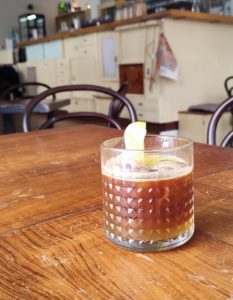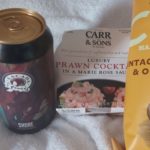 The trouble with writing something on a weekly basis is you notice that another week has passed. This is why I don’t shave every day. Looking at the same mug in the same mirror at the same time each and every morning? No thanks. You notice too much. Like that one third of this summer is already done. And the last three weeks don’t even count. Panic! Panic!!! Max is having none of it. He is squeezing every moment out of the good weather – and has found a new cocktail to go along with it. I say cocktail but it seems to be booze free: “The coffee is hot. Then they mix it with tonic and ice, add the lime and you get a glass of refreshing goodness.” I will have to try that.
The trouble with writing something on a weekly basis is you notice that another week has passed. This is why I don’t shave every day. Looking at the same mug in the same mirror at the same time each and every morning? No thanks. You notice too much. Like that one third of this summer is already done. And the last three weeks don’t even count. Panic! Panic!!! Max is having none of it. He is squeezing every moment out of the good weather – and has found a new cocktail to go along with it. I say cocktail but it seems to be booze free: “The coffee is hot. Then they mix it with tonic and ice, add the lime and you get a glass of refreshing goodness.” I will have to try that.
Heatwave. Euro heatwave. Best place to be? In an old pub painted white on the outside with thick insulating walls and a hearty aircon system? Worst place to be? In the car when the prosecco blows. Or working in a brewery for that matter, as one witness confesses. Fact: 3.6 times more people in the UK think drinking beer is a proper way to beat the heatwave than eating iceberg lettuces. Plural. That’s what the graph says – floating, a little alienated even, just there above this Bloomberg story. Looks like Tesco’s estimate for sales this past week:
…there’s pressure on retailers too, though more to keep the nation in supply of its summer quenchers. Supermarket chain Tesco Plc expects to sell more than 9 million ice creams and lollies in the coming week, a record. The supermarket also expects to sell 9 million bottles and cans of beer and 50,000 bottles of Pimms, the classic British summer gin-based fruit drink… Peas, lettuce and apples are particularly susceptible, he said, and crops can’t be shielded. “It’s not catastrophic — it happens,” said Ward. “Extreme heat is uncomfortable for people and plants.”
Either way, bad week to be a lettuce: get eaten or burn. Perhaps making matters worse for the the green crunchies, it appears that some lab coated type people are telling some other not lab coated people to lay off the sauce when being slowly roasted during a heatwave:
“Alcohol is a diuretic, which means it encourages the kidneys to lose extra fluid. That is why you tend to go to the toilet to urinate (pee) much more when you drink alcohol. Alcohol also makes you sweat more. The combination of sweating more in the heat, and going to the toilet more, means you lose more fluid than you take in and become dehydrated unless you replace that lost fluid by drinking water.” Official guidance also urges people to avoid caffeine during the hot weather for the same reason.
WHAAAAATTT!!! Hot cuppa tea is the best thing on a hot day. That’s what Grannie always said. Never mentioned lettuce either, come to think of it. And they call themselves scientists.* Thankfully, the New York Post found a couple of people perhaps partially of the lab coated variety to root for beer as the mercury climbs:
…in the midst of an international heat wave, one physician on Twitter claimed beer can help with hydration. Academic Ellie Mackin Roberts sparked a now-viral debate when she recently tweeted 10 steps to help beat the heat. Tip No. 9 read: “If you are dehydrated (and an adult, and able to do so) drink a half a pint of beer (inc. alcohol free!) and then move straight onto water (or a sports drink or cordial if you don’t like water).” Followers of Roberts, an expert in ancient Greek history, quickly responded, questioning how beer could ever be helpful in trying to avoid dehydration. However, Dr. Stuart Galloway, of the University of Stirling told Femail that the beverage contains electrolytes, sugar and salt, which helps the body retain fluid, rather than it going straight through.
Gary added an interesting but also labcoatless and lettuceless post on the conditions in pubs in Halifax, England in 1932 and how the local establishments managed another heatwave ninety years ago:
“The public do not realise the trouble we have to go to, to keep our beer cool,” one licensed victualler said. “When you have a rock cellar as we possess, the business is bad enough, but publicans that do not possess this advantage have a busy time trying to cool their beer. Some of the best bitter beers require nursing if our customers are to be satisfied in these hot days,” he continued, “and even with advantages regarding cellarage I have to keep a succession of wet sacks over my casks to keep them cool.” In one restaurant sacks, thoroughly dampened, are placed over the casks of beer, and from time to time a system of sprayers pours ice-cold water over them.
That’s the spirit – and at least they were not resorting to putting crap in the lager and calling it innovation! Honourable mention and a big “thanks for coming out” for at least shitting on the 2009 video “I am a craft brewer” even if it took them thirteen years to admit how stupid it was. All very “wad some Power the giftie gie us“… Dave! Some are still unaware.
This week in beer writing mildly troubling angst: dashes.
Health update: booze bad. Relatedly, in Jerard Fagerberg’s disappointingly brief but excellent interview (within an important health confessional of sorts) former beer writer Norm Miller shares some thoughts on his 2018 decision to back away from drinking:
During his tenure, Miller became synonymous with the Massachusetts beer scene. But by 2018, Miller was drinking too much. As an obese man in his 40s, he needed a holistic lifestyle change. He never felt physically addicted, he says, but the pressures of being in the beer media were indeed getting to him. “I didn’t consider myself an alcoholic, I just drank because I felt like I should keep up with everything,” he says. “It was a combination of trying to keep up with everything and sincerely liking to try different things. It was a bad combination. I decided to step away, because my health was more important than a weekly column.”
PS: Norm‘s normal now… nearly. I applaud the raising of the ill effects of booze but it is sad to see it hidden in the lower shelf of GBH well behind all the regular dubious claims to fame for booze.
Canadian craft Faxe weekly update.
 Note: there are upsides to the heat or at least a moderate amount of it. The barley crop in Ireland is loving it, according to grower and not well dead poet, John Dunne: “…grain fill looks really good. You can’t beat sunshine to put weight in grain.” And, did you know, that actual grains make interesting flavours that can be expressed though a resulting booze-laden beverage? No, really. Apparently adding buckets of jam is not required according to this heads up from Curmudgeon Ale Works citing an article in Modern Farmer:
Note: there are upsides to the heat or at least a moderate amount of it. The barley crop in Ireland is loving it, according to grower and not well dead poet, John Dunne: “…grain fill looks really good. You can’t beat sunshine to put weight in grain.” And, did you know, that actual grains make interesting flavours that can be expressed though a resulting booze-laden beverage? No, really. Apparently adding buckets of jam is not required according to this heads up from Curmudgeon Ale Works citing an article in Modern Farmer:
“There were a few older, open-pollinated varieties that really didn’t taste very good. But then there were a few that were absolutely stunning. And what fascinated us was that all of the hybrids kind of tasted the same.” Time and time again, the flavor of the heritage and heirloom grains outperformed the hybrid rye varieties—but that doesn’t mean hybrids don’t have their place. Swanson still grows hybrid grains, such as the popular AC Hazlet, because they “are incredibly robust in the field,” he says. “They give beautiful standards, they yield astronomical amounts.
Pay attention, brewers. And an addendum to last week’s comment about medieval alcohol making:
Later this week blackcurrants are going to make wine too… farmers will convert anything to alcohol, it’s our superpower…
In addition to all its issues, craft beer also has a labour problem, according to this excellent and detailed article by Julie Rhodes:
Think about it this way, if the 1990s were like the kindergarten stage of the overall craft beer industry journey, full of wide-eyed enthusiasm and experiential learning moments, the 2020s are proving to be like middle school – full of angst, infinite possibilities, and pivotal decision-making that will determine the long-term future of the industry. We will have to wait to see if the cool kids can mature enough to make equitable and mutually beneficial decisions that will carry this industry beyond the awkward stage, but many are hopefully optimistic.
AKA the era of the spotty faced gits. I like it.
And finally a question: why bother with B.O.B.s** (or W.O.B.s for that matter) set in places you will never see and drinks you will never have? Among the usual questions about veracity in drinks writing, don’t these reach a further level of abstraction from reality, so far that they might as well be entirely made up? A sort of social science fan fiction?
For more, check out the updates from Boak and Bailey mostly every Saturday but not from Stan every Monday as he is on his summer holiday. Check out the weekly Beer Ladies Podcast, and at the weekly OCBG Podcast on Tuesday (Ed.: with a good discretion of the purchase of Amsterdam’s recent buyout by Danes this week at about the midpoint but avoid around the 24th minute if you don’t care for sputum) and sometimes on a Friday posts at The Fizz as well. There is a monthly sort of round up at The Glass. (Ed.: that seems to be dead now.) There is more from DaftAboutCraft‘s podcast, too. And the Beervana podcast. And sign up for Katie’s (Ed.: now very) irregular newsletter, The Gulp, too. And check out the Atlantic Canada Beer Blog‘s weekly roundup. Plus follow the venerable Full Pint podcast. And Fermentation Radio with Emma Inch. The AfroBeerChick podcast as well! And also look at Brewsround and Cabin Fever. And Ben has his own podcast, Beer and Badword (Ed.: …notice of revival of which has been given… still not on the radio dial…) And remember BeerEdge, too, and The Moon Under Water. There has also been the Beer O’clock Show but that’s wound up now after ten years.
*Other points of view have been circulating.
**Beer Owner Bios, that sort of subset of puffery that is as close to press release reporting as there is… well, except for when that’s all it actually is…

I was VERY disappointed to find that Curmudgeon Ale Works wasn’t a microbrewery set up in the shed of Stockport’s top pub blogger.
Seems to be a clear case of appropriation!